
arcads ai: From Idea to Ad in an Hour
Start the clock, friend. Arcads gets your first ads live before lunch so you stop guessing. When the data smiles, hire a creator to remake the hits with real faces and better footage. You get momentum and money well spent.
Friend to friend: a few links are affiliate links. When you purchase, I might get a tiny thank-you from the company, with zero added cost to you. I only recommend things that I’ve actually tried and looked into. Nothing here is financial advice; it is for entertainment. Read the full affiliate disclosure and privacy policy.
You want sales this week, not someday. Use Arcads to spin up testable UGC-style ads in under an hour, then hire creators to remake only what works. Spend where the signal is strong.
Early on, velocity matters most. Third-party reviews show Arcads can help you stand up multiple variants quickly, which means more shots on goal this week.
As winners emerge, creator content lifts trust and gives you usage rights for paid distribution. Price bands help you plan: many UGC videos land near the $150–$250 range before rights.
Platforms also reward fresh creative, so expect to refresh often as performance drifts.
This guide gives you the stopwatch, the budget math, and the hybrid plan to get live today and compound results over the next seven days—without overthinking the tools. We’ll keep it practical, plain, and test-ready.
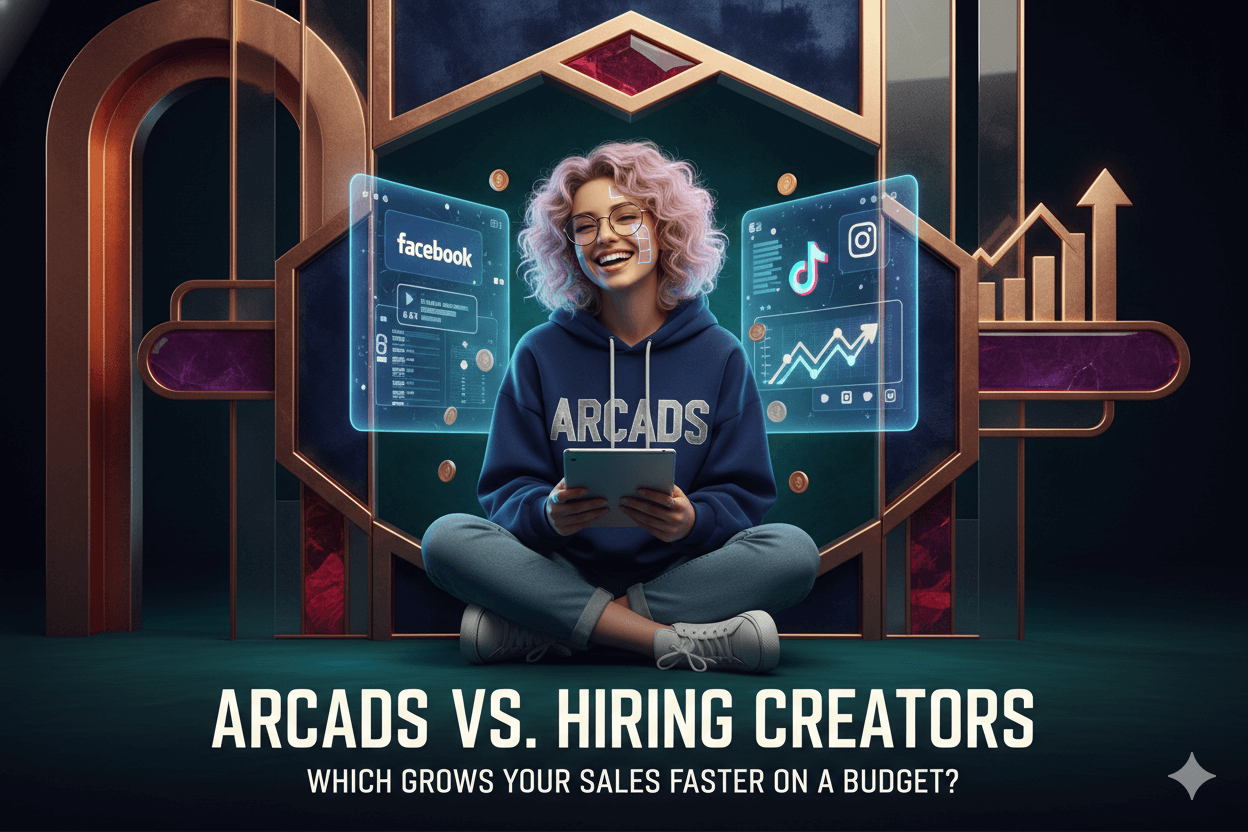
Decide Fast: Arcads or Hiring Creators? The Real Job to Be Done
Pick the path that ships a test today, then buy trust next.
Use the option that gets a real test in-market today, then invest in the format that compounds trust and rights tomorrow. Arcads shines for speed and volume of early hook tests.
Creators shine for authenticity, licenseable assets, and durable distribution. A hybrid flow wins most often. – Hero Influencer
What “AI UGC” actually means in ads
AI-UGC refers to short, UGC-style videos generated by software using script inputs, stock or uploaded visuals, and virtual “actors,” so you can produce multiple variants without filming.
Reviews of Arcads describe generating realistic UGC-style ads in minutes from simple inputs. This makes it suited to rapid hypothesis testing of openers, value props, and CTAs when you need results now.
Creator-UGC is made by real people who record product demos, try-ons, or tutorials for your brand.
It carries social proof and lived detail that audiences recognize as human, which often helps conversion once you’ve identified winning angles.
Guides for brands frame UGC creators as the better bet for conversion volume, while influencers skew to awareness.
The hybrid answer: test with AI, scale with creators
Treat Arcads as your speed lab. Spin up 10–20 hook variants, publish, and read early signals to rank concepts.
Independent reviewers position Arcads exactly this way: a fast lane to realistic, testable UGC-style ads without shoots or editing.
Then hand the top two or three angles to human creators to reshoot with real faces, product handling, and context, and to negotiate usage rights and allowlisting for paid.
Industry guidance recommends this mix: creators for authentic, conversion-oriented content and influencers for reach, with AI accelerating the discovery phase.
Consumer trend reporting also shows audiences responding to relatable, community-led content, which supports moving winners into creator-made assets once the hook is proven.
Speed, trust, reach: pick two for each phase
Map priorities by phase:
- Discovery: optimize for speed and breadth of ideas. Arcads helps you cover more angles per dollar and per day, so you learn faster which messages clear the first three seconds.
- Validation: add trust by commissioning creators to re-film the winning angles and to secure licensing and allowlisting for paid syndication.
- Scale: extend reach by mixing creator assets with influencer placements and continued AI-driven iterations to refresh hooks as fatigue appears…this sequencing aligns with third-party Arcads reviews on rapid generation, with creator-platform guidance on role clarity, and with current consumer preference for authentic, community-rooted content.
Speed to First Ad: The 60-Minute Arcads Playtest SOP
From blank doc to live test in under 60 minutes.
From blank page to a real test in one working hour is realistic if you plan the steps and protect the stopwatch. – Codingem
Reviews describe Arcads as a fast lane for UGC-style ads; vendor material and neutral tool pages indicate clip renders measured in minutes, not hours. Work with a range—about two to ten minutes per video—so you can batch intelligently.
Your one-hour checklist
Script five to ten short hooks. Gather one product image or screen capture per variant. In Arcads, pick an on-brand actor, paste each hook, and queue renders.
Third-party reviews and tutorials show this workflow producing testable clips quickly; Arcads’ own guide states “approximately 10 minutes,” while a neutral tool page reports “about two minutes,” so assume variability by length and queue.
Export vertical 9:16 files, add captions if needed, and prepare titles, UTMs, and placements.
Batch and label for clean readouts
Name each creative with a clear schema: HOOK_theme–offer–cta–v01. Keep one variable per variant so results map to a single learning.
Upload to TikTok Ads Manager and/or Meta with consistent ad-set settings, then duplicate to deploy your set of hooks in parallel. Platform guidance emphasizes frequent refresh and a steady pipeline, which batching unlocks.
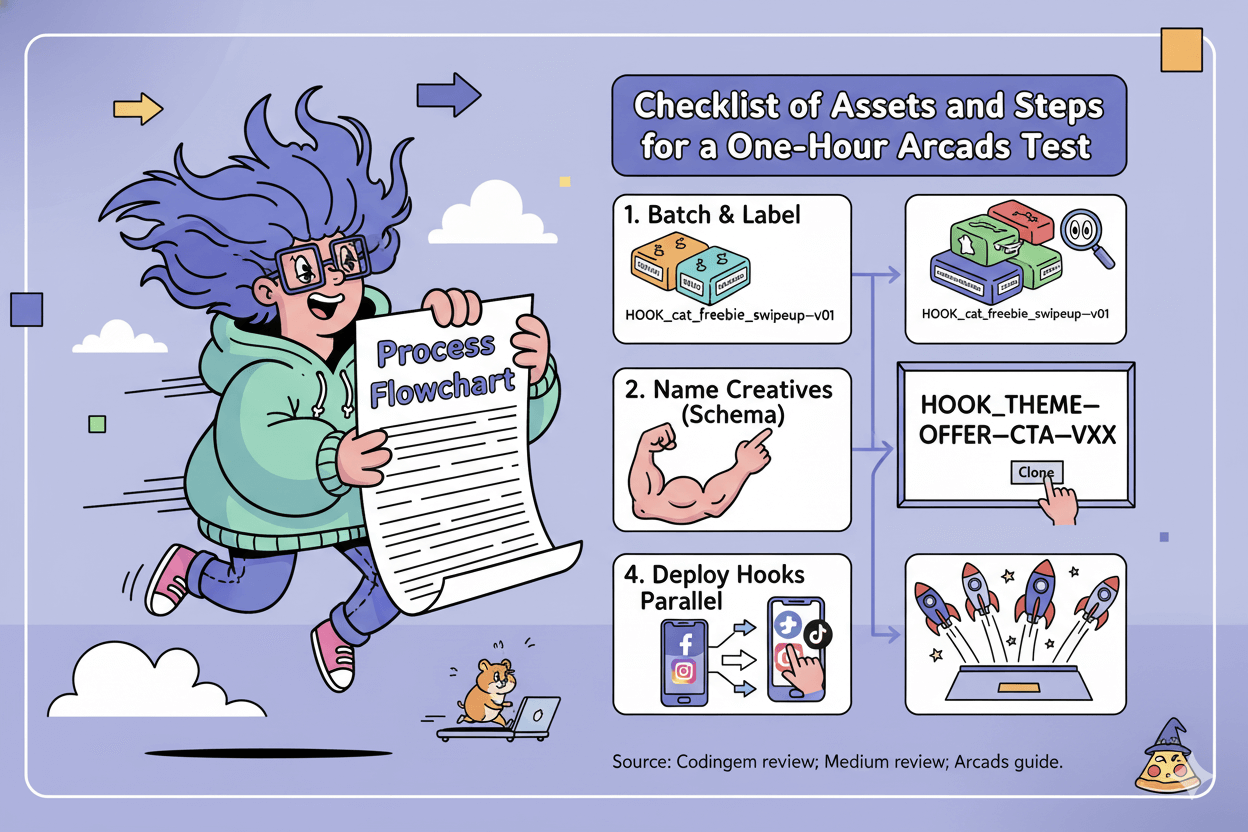
First-day read: what to watch and when to cut
Set a small learning spend per variant and monitor early indicators. On TikTok, check that delivery and view-through begin cleanly; refresh when trend lines slip and keep a consistent supply of new creatives in rotation.
Many practitioners refresh faster at scale, so treat day-one reads as screening, not verdicts. Retire low-engagement hooks quickly, keep two or three top performers, and spin fresh micro-variations on those openers to confirm signal.
Pro_tip: Plan two render waves inside the same hour. Queue five hooks, publish three that meet your quality bar, then refill the queue while ads start spending. The two-to-ten-minute render window makes this cadence workable in a single session and increases your chance of ending the hour with 6–8 live tests.
Myth_buster: You do not need heavy polish to get a read. Both TikTok guidance and independent reviews favor platform-native pacing, quick hooks, and frequent refresh over perfect production. Your objective on day one is speed to learning, not cinematography.
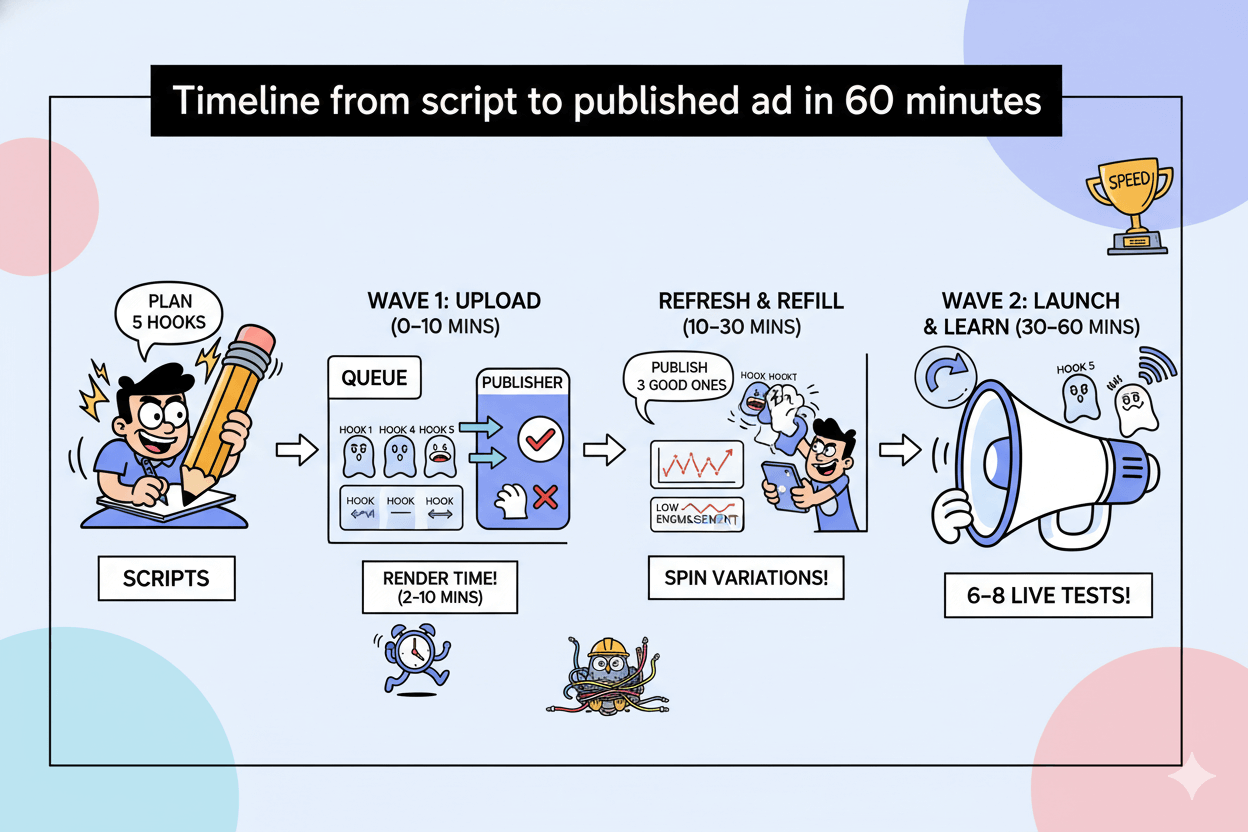
Budget Math: Effective Cost per Iteration vs Hiring Creators
Judge by cost per learn, not cost per file.
Your first week is about shipping many testable angles, reading signal, and only then funding polished assets. So frame the math around iterations you can afford in seven days… not just the sticker price of a single video.
Creator pricing levers: rights, revisions, turnaround
Most short UGC videos land near $150–$250 per deliverable across niches and platforms. Entry projects can price $50–$100, while established creators often command $500+.
Packages raise totals as you add deliverables. Usage rights, allowlisting, and rush timelines increase price meaningfully, so budget beyond the base rate.
A simple way to estimate a post-production total is: creator base rate × quantity + rights premium. Many brands see rights add a sizable percentage on top of the base.
Keep this in the scope from the start so your test budget matches reality.
Arcads “effective cost per video” at different volumes
Third-party overviews and comparison pages consistently place Arcads’ entry tier at roughly $100–$110/month for 10 generations—about $10–$11 per video.
Mid tiers double the quota near $220 for 20. Treat these as directional, then re-verify at publish time because vendor pricing can change.
Why this matters: if your goal is to test 10–20 hooks this week, Arcads converts one monthly fee into many learnable iterations.
That shifts the budget conversation from “what one asset costs” to “how many ideas you can afford to validate before scaling.” – Billo
| Scenario | Variant count | Inputs | Total creative spend | Effective cost per iteration | Notes |
|---|---|---|---|---|---|
| A — Arcads (Starter) | 10 | Entry tier ≈ $100–$110/mo for 10 generations | $100–$110 | $10–$11 | Minutes-level generation; re-verify tier limits |
| A — Arcads (Growth) | 20 | Mid tier ≈ $220 for 20 generations | $220 | ≈ $11 | Same fee model, doubled quota |
| B — Creators (First Reads) | 10 |
Base: $200 avg per short UGC video Rights package (usage/allowlisting) +40% illustrative |
Base: $2,000 With rights (+40%): $2,800 |
Base: $200 With rights: $280 |
Ranges vary: typical $150–$250, entry $50–$100, established $500+ |
| C — Hybrid (Recommended) | Arcads 10–20 + Creators 2 |
Arcads: $110–$220 Creators: 2 × $200 = $400 (rights extra) |
$510–$620 (+ rights) |
Arcads tests: $11 each (10–20) Creator remakes: $200 each (+ rights) |
Pay for proof, then scale; negotiate duration/platforms/territory④ |
Seven-day testing budget: three worked examples
Scenario A: Arcads starter week.
You plan 10 variants. Subscription ≈ $110 covers all 10. Effective cost per iteration ≈ $11. If you push to 20 variants, step up one tier ≈ $220 total, still ≈$11 per iteration. Re-check current plan limits before you publish numbers.
Scenario B: Creators for first reads. Ten short videos at a conservative $200 average cost $2,000. Add a modest rights package (illustrative +40% for usage/allowlisting) and you reach $2,800.
That’s $280 per iteration before media. Your cost is higher, but you gain human authenticity and licenseable assets.
Scenario C: Hybrid week. Run Arcads 10–20 variants to find two winning hooks ($110–$220). Then brief a creator to remake only those winners: 2 videos × $200 = $400, plus rights as needed.
Your total to first proof is $510–$620 plus rights, yet you avoided paying for ten creator shots that never earned scale.
Pricing changes. Verify tiers and inclusions before you publish or screenshot. Comparison pages and reviews sometimes trail vendor updates by weeks.
Refresh Cadence: Meta vs TikTok Triggers You Can Trust
Swap creative when the graph whispers, not when it screams.
TikTok’s own guidance is clear: check performance routinely and refresh when delivery trends slide, and keep a steady supply of new creatives ready to rotate.
On TikTok you can also lean on Smart Creative to auto-mix assets and fight fatigue at the ad-group level. On Meta, many performance teams plan refresh windows by spend and frequency.
Agencies report longer life at low budgets and much shorter cycles as you scale, which matches real-world outcomes.
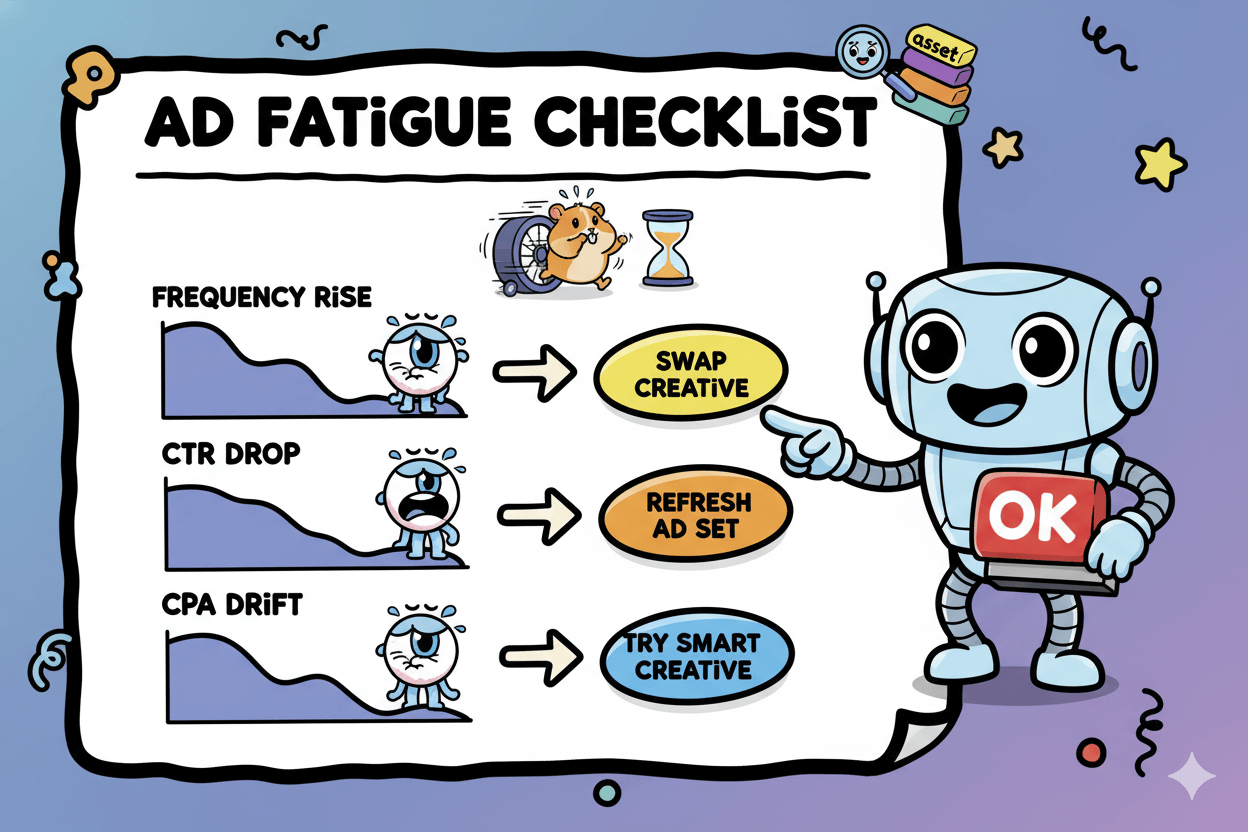
Metrics that scream fatigue: frequency, CTR, and CPA drift
Watch trend lines first. TikTok says to refresh creatives when delivery results show a consistent decline, which you’ll feel as CTR softens and costs creep. In Meta, a simple leading indicator is frequency climbing while CTR stalls or falls.
Practitioners often use a soft trigger around frequency ~2.5–3+, then confirm with performance against your breakeven before swapping. Treat this as a heuristic, not a law.
If your CPA drifts above goal for several days and the top-of-funnel hasn’t changed, prioritize new hooks over bid tweaks.
TikTok refresh systems: built-in automation and a pipeline of ideas
TikTok’s Smart Creative can detect fatigue and auto-refresh combinations without manual rebuilds. Use it to extend ad-group lifespan while you keep feeding fresh cuts.
Pair automation with a human pipeline: aim to queue 5–10 new hook variants weekly, then let the system remix them.
TikTok’s broader creative guidance also pushes a steady cadence of new assets so you’re never stuck when a trend cools.
If you’re running Smart+ campaigns, review the creative-centric reporting to see which mixes are decaying and where to inject new angles.
Scaling spend? Shorten the cycle
As budgets rise, fatigue accelerates. Agencies note that the “same” asset might work for ~30 days at modest spend yet fade within a week at heavy spend because reach and frequency ramp faster.
In practice that means planning more frequent refresh on TikTok during scale and roughly 2–4 week cycles on Meta at moderate budgets, tightening further as frequency rises.
Use platform resources like TikTok’s Creative Center to spot rising sounds and structures for your next batch, then rotate winners into your ad sets before decay shows up in the graph.
Pro_tip: Build a standing creative calendar tied to signals, not dates. If frequency pops and CTR fades, swap in two fresh hooks immediately. If trend lines hold, let winners ride another few days and spend your energy on next week’s concepts.
Do’s_and_don’ts: Do ship small, frequent variations that refresh the opener and the first visual beat. Don’t wait for a hard crash; rotate when decline becomes consistent. On TikTok, let Smart Creative do the remix work while you keep inventing the next hook. – Tiktok For Business
When to Hire Creators: Authenticity and Rights That Compound
Use creators when proof and permissions decide the sale.
Real people show real use, handle your product, and answer silent objections in a way AI cannot.
Creator content also comes with licenseable rights, which lets you run paid distribution from creator handles or from your brand without takedown risk.
Use AI to find winning angles fast, then commission creators to remake those winners for scale. This blend matches current guidance that positions UGC creators for conversion and volume, with influencers adding reach when needed.
Authenticity as a conversion lever
Creator-shot UGC works because viewers recognize human nuance: imperfect lighting, natural speech, and believable context.
Insense’s comparison guide recommends creators when the goal is performance content you can reuse across ads, product pages, and emails.
It positions influencers for buzz and visibility, and UGC creators for steady assets that drive action. That split helps you stage investment: validate hooks with Arcads, then film the top two or three angles with creators to lock trust.
Rights that matter: term, territory, allowlisting
Costs change when you add rights. Rate guides show usage rights, allowlisting, and paid amplification as major price drivers, which is why a cheap base rate can double once terms are added.
Spell out duration, platforms, and geography in writing.
On Meta, branded content and Partnership Ads involve running paid from creator identities under specific policy, which is why creator access and handle permissions carry a premium.
On TikTok, Spark Ads require creator authorization so you can boost the original post or run from the creator handle, and those permissions expire unless renewed.
Build these mechanics into the brief, the contract, and your budget so distribution never stalls.
Graduate winners from AI to human creators
Run Arcads to generate 10–20 quick variants and read the early signal.
When a hook clears your benchmarks, shift it into a creator brief with exact opener, proof, CTA, and required rights. Many brands then allowlist the creator asset to capture social proof while keeping media control.
If you need a refresher on common right types and their pricing effect, use recent licensing guides as a checklist before you sign. This keeps the pipeline moving from discovery to validation to paid scale without surprises.
Briefs That Win: AI vs Human Creator Templates
One hook, one proof, one CTA. That’s the brief.
Keep them short, specific, and channel-aware. Define the opener, the proof you’ll show, and the action you want in plain language. Avoid vague goals, overstuffed asks, and jargon.
Recent brief audits call out vagueness, missing core elements, misaligned direction, and overload as the most common failures. Your fix is a tight, prioritized one-pager that a creator—or an AI tool—can execute without guesswork.
A TikTok-first brief also respects the platform’s creative codes: vertical, sound-on, quick movement, and a strong first second.
TikTok’s help docs and best-practices blog reinforce a DIY aesthetic, trend alignment, and frequent creative refresh.
That means your brief should name the sound or trend pattern, specify safe-space framing, and keep scripts simple and conversational. The goal is scroll-stopping clarity, not polish.
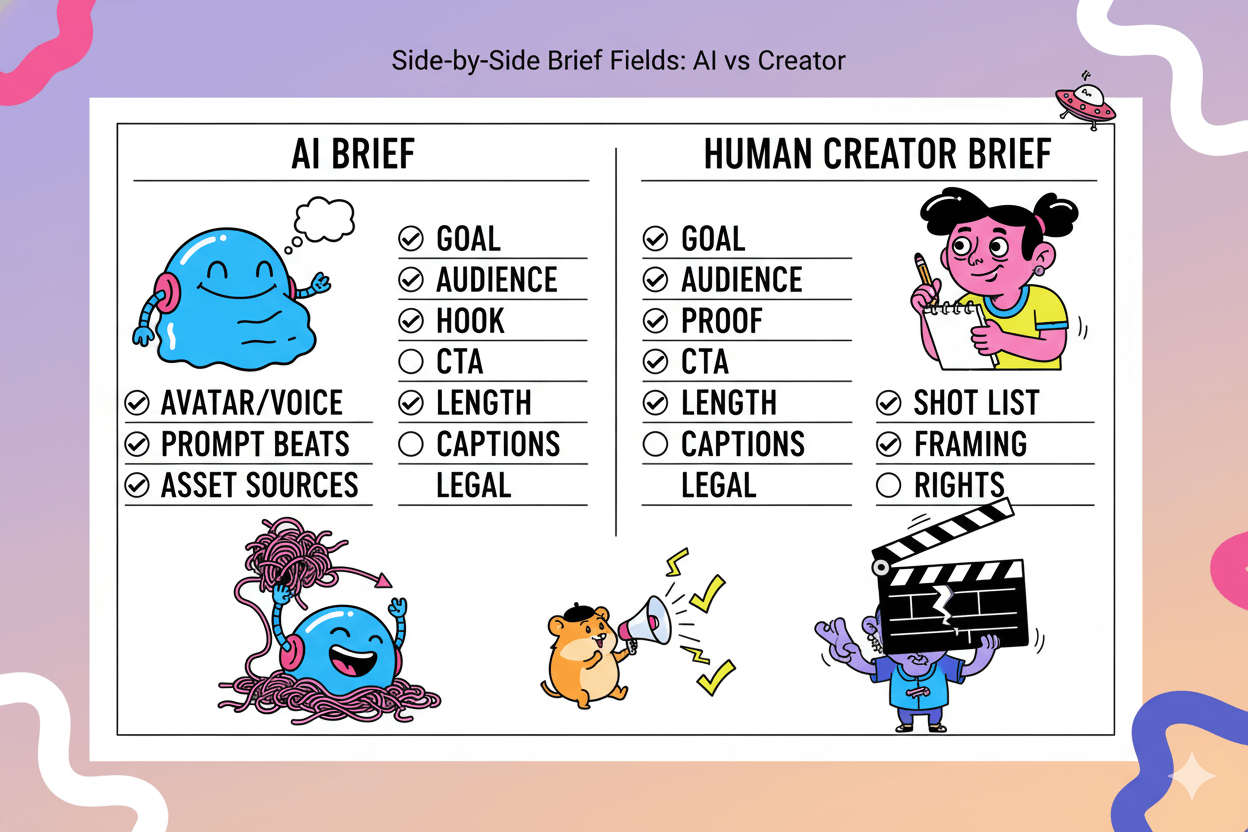
The hook stack: opener, proof, CTA
Write three beats in one line each.
- Opener: the pattern interrupt your audience expects on TikTok. Name the first on-screen line and the first motion.
- Proof: what the viewer will see that supports the claim (demo step, split-screen comparison, ingredient close-up).
- CTA: the tap you want and the exact button text.
TikTok’s guides stress TikTok-first storytelling, fast pacing, and frequent refresh, so your hook stack should fit a 5–9 second frame with vertical composition and UI-safe margins.
The creator checklist: rights, revisions, turnaround
Give creators everything they need and nothing they don’t. Include deliverables, run time, must-say phrases, required shots, brand words to avoid, prop list, and deadlines.
Price levers like usage term, allowlisting, and territory belong in the brief so quotes reflect reality; rate guides and audits show rights as major multipliers.
Specify revision count and a realistic turnaround window. This prevents scope creep and keeps your test cadence on schedule.
The AI checklist: prompts, avatars, safe claims
For Arcads or similar tools, your brief becomes a prompt spec. List the hook script per variant, on-screen text, desired avatar/voice style, length, aspect (9:16), and asset sources (product shots, screens).
Add compliance constraints and banned claims. Close with file naming, caption rules, and the number of variants to render.
Platform guidance still applies: vertical format, early motion, and frequent refresh, so design prompts around those beats.
Pro_tip: Attach one winning example and one “do not do” clip. Examples cut ambiguity and speed delivery—Billo’s brief review highlights clarity and priority as the fastest way to reduce back-and-forth.
Your 7-Day Hybrid Plan: Test Fast, Then Scale What Works
Ship on Day 1, lock briefs by Day 3, scale by Day 7.
You do not need a long runway. You need a week with clear checkpoints. Use Arcads for rapid discovery, then move only proven angles into creator production with rights that let you scale.
Day 1 setup and launch
Block one hour to script 10 short hooks, pick on-brand avatars, and render a batch of vertical clips.
Independent testers report minutes-level generation, and neutral tool pages cite about two minutes per clip, so plan in short waves and publish the first winners the same day.
Upload to TikTok Ads Manager and Meta with clean naming and UTMs. Keep one variable per variant so each result maps to a single learning.
TikTok’s guidance is to monitor performance and refresh when delivery trends decline, so queue extra variants now to maintain supply.
Day 3 decision gates and briefs
By 48–72 hours you will see early separation on hook strength. Pause weak variants and shortlist two or three leaders.
Draft creator briefs that mirror your top Arcads openers: one hook line, one visual proof, one CTA, plus deliverables, length, aspect, revision count, and deadlines.
Brief audits flag vagueness and overload as the most common failure modes, so keep it simple and specific.
Insert rights requirements into the brief so quotes match reality.
Rate guides show base deliverable prices rising with usage, allowlisting, and turnaround, which means planning rights early prevents rework later.
Day 7 refresh and rights plan
Lock creator slots for your two or three best angles, then set a refresh cadence.
Agencies report Meta assets often hold for roughly 2–4 weeks at modest spend and decay faster as budgets climb, while TikTok typically demands quicker rotation. Build a pipeline that replaces tired creatives before the chart dips.
On TikTok, use Creative Best Practices as your guardrails and keep a consistent inflow of new assets. If fatigue appears, rotate immediately and consider Smart Creative features to remix combinations while you prep the next batch.
If your plan includes paid whitelisting or Spark Ads from creator handles, confirm contract terms: duration, platforms, territory, and any allowlisting permissions. Rights are a major price lever and should be explicit before production starts.
Micro_challenge: This week, ship 10 Arcads variants on Day 1, shortlist by Day 3, and lock two creator briefs by Day 5. Use day-7 to rotate in fresh Arcads hooks and set rights for creator remakes so you enter week two with new ads live and legal ready.
Conclusion
Move with speed, then buy trust. Arcads gives you low-cost, minutes-level variants so you can test 10–20 hooks today and learn which openers earn attention without booking a shoot.
Independent reviews and tool pages frame this as its core strength: rapid, realistic UGC-style ads for first reads.
Once you see signal, shift into creator mode. UGC creators deliver the human texture that lifts conversion and, crucially, the usage rights and allowlisting you need for paid scale.
Current guides put many short UGC videos around $150–$250 each, with entry work at $50–$100 and seasoned creators at $500+ before rights; plan for terms, territory, and whitelisting to raise the final number.
Keep a refresh pipeline. TikTok’s documentation recommends checking performance frequently and refreshing when delivery trends decline, and its creative best-practice articles reiterate that even strong ads fatigue.
Agencies report Meta assets often cycle every 2–4 weeks, while TikTok demands faster rotation at higher spend. Treat these as starting points and watch your own frequency, CTR, and cost trendlines.
The winning play is a hybrid: validate concepts with Arcads for cost-per-iteration efficiency, then graduate proven angles to creator shoots for authenticity and rights.
This mirrors platform guidance on freshness and creator-platform advice on role clarity, and it aligns with how audiences increasingly reward relatable, community-rooted content.
Set a weekly cadence: batch new Arcads variants, prune losers, brief creators on the top angles, and lock rights before scale. You get the best of both worlds—speed that compounds learning and credibility that compounds revenue.

Arcads ai: Test Cheap, Win Big




